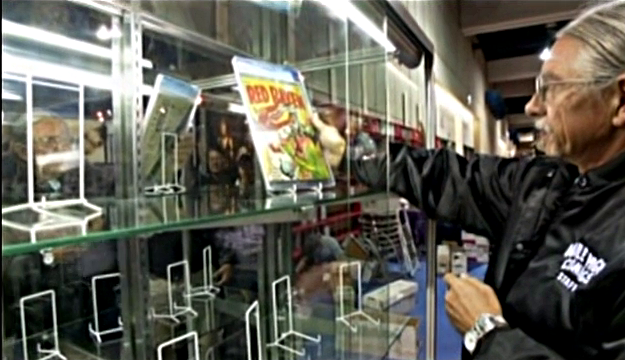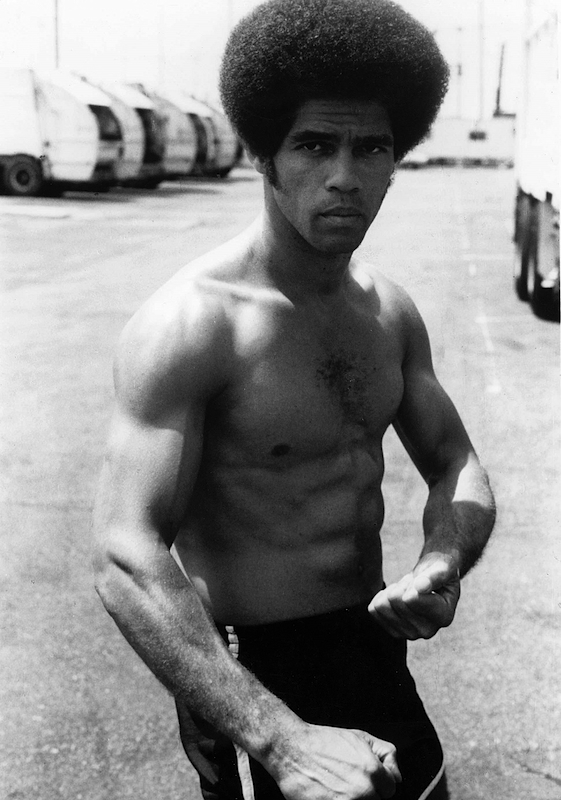It seems like I'm the oddball in a world of very normal people. But when I dream about going to a place like Comic-Con, it's got to be, like, nirvana, it's got to be the closest thing there is to heaven, because other people there are just as much of a nerd as I am. - Eric Henson
I last went to
Comic-Con International just as the convention was beginning to grow into its present-day form. I was playing it by ear the day I took the train down to San Diego, and for the first time in my life the hotels in the downtown area were fully booked. But I could still line up and purchase a 4-day pass. By contrast, tickets for this year’s event sold out in just over 90 minutes, which is now becoming typical since attendance was capped in 2008. Social media plays a bigger role in reporting what happens at the Con. Everyone online complains about the endless queues to get into some panels, the overcrowded halls, or the smell of 130,000 sweaty people in close proximity to each other during the height of summer. Then there’s the resentment over how much space, both literally and figuratively, Hollywood occupies at the convention. Comic-Con’s late founder
Shel Dorf said back in 2002: "It's become too big and too depressing... The last time there, I could barely find any comic books." The situation has hardly improved for devotees of the medium. But you know what? Given half the chance, I’d attend Comic-Con again in a heartbeat.
Documentary film maker
Morgan Spurlock is known for putting himself front-and-center during his satirical takedowns of Western consumerism. So it was with some trepidation that I first approached the rather annoyingly titled
Comic-Con Episode IV: A Fan's Hope. It’s ironic verbosity is second only to
POM Wonderful Presents: The Greatest Movie Ever Sold, which is a good example of how Spurlock's social critiques are premised on executing an elaborate stunt. But to my surprise, there are no stunts here and Spurlock himself is nowhere to be found in front of the camera. And while the observation that geek subculture has finally ascended the heights of mainstream entertainment still fits within Spurlock’s wheelhouse, the positive message that geeks are people too is a delightful twist.
Spurlock has lined-up a huge list of nerd idols to function as talking heads guiding the audience through Comic-Con’s 2010 event, including the film’s producers
Harry Knowles,
Joss Whedon, and
Stan Lee. Combined with a random sampling of the diverse range of fans wandering the convention hall, this collection serves to emphasize just how much Comic-Con mirrors the popular landscape. Sure, not all of them are there for the comic books. But rather than seeming a depressing sight, there’s a powerful feeling of euphoria that envelops this motley crew. This is summed up by Whedon’s comment:
“I've brought people who'd never been to the Con and seen the look on their face that was on my face, which is, 'My tribe! I have found my tribe!’ Like, it is a time when these people can express themselves in a totally safe environment and it doesn't matter what they're a fan of."
The narrative's meat is supplied by six attendees: Two aspiring artists, an aspiring costume designer, a longtime comics retailer, and a romantically involved couple. As someone who’s been there and done the whole portfolio review process, I quickly identified with the two artists, who could not have been more different from each other. Young hopeful
Skip Harvey, who tends a geek-themed bar, is the closest thing to a stereotypical fanboy of the main cast. He’s first shown engaged in a debate on who would win a fight between
Black Cat and
Longshot which concludes with the two characters having sex. His parents were active trekkies. He sports a
Flash Tattoo. He sleeps on a
Spider-Man themed pillowcase. I wanted to yell at him to lose the hat and kiddie
Marvel backpack where he stuffs his artist portfolio. This is a fuckin’ job interview, man. Was I ever that naive? The more clean-cut
Eric Henson is stationed at a military base in the middle of nowhere. But he admits to living a double life as a nerd. He draws a mean
Hulk and dreams of working for Marvel Comics. But going to Comic-Con is a big adjustment for someone unused to city living, let alone the California lifestyle. And it means temporarily leaving his adorable daughter and supportive wife, who's nonetheless perplexed with his decision. There’s no denying their passion for drawing comics, and their experiences brought back for me the personal dread that comes from the long waits and terse silence that commences every critique.
Holly Conrad is the film’s most charming character, and her “suicide mission” to get her cosplay troupe to Comic-Con’s Masquerade provides the film with it’s most exciting buildup as well as its most satisfying emotional payoff. It’s the kind of triumphant moment fans dream of. I love her amusing description of the piss-town she lives in as a place “where people stop to go to the bathroom on their way to go skiing” and her good-natured characterization of her neighbor’s misguided view of her as a meth head.
Veteran exhibitor and
Mile High Comics proprietor
Chuck Rozanski represents Comic-Con's old guard. His story is presented as a struggle to keep his business afloat as the annual event becomes less a true comics convention. This is news to me given how much of a fixture Mile High is at Comic-Con. Much hay is made out of whether or not he'll sell a personal treasure - an ultra-rare copy of
Red Raven #1, though I never doubted the eventual outcome. While there’s not much that actually happens to him, Chuck is the most eloquent main character in the film and the only one to view the Con from a long term perspective.
James Darling and
Se Young Kang began dating at last year’s Comic-Con. James plans on proposing to Se Young during the
Kevin Smith panel. But he runs into a few obstacles along the way. While their plotline is actually uncomplicated, it’s a cute way to round out the cast. And Kevin proves to be a gracious host.
While the use of visual gimmicks like comic book panel transitions, caption boxes written in comic-style typeface, and superhero code names are a tad cliche, they serve to help delineate and juggle the different plot threads. Spurlock makes the clever choice not to so much fixate on his cast’s interests and Geeky obsessions but on their aspirations and personal struggles. The film follows them from their respective homes, families and dayjobs, to their experiences during the 4 days at the Con, to the time they’re about to leave. The results are cathartic. Though their individual stories are small, the audience gets to root for them and share in the fruits of their labor, whether for good or bad.
This approach sounds straightforward enough, but it’s remarkable how rarely it’s used whenever any kind of geek-oriented subculture is being covered by the mainstream press. It’s more typical to gawk at their strange pursuits, then characterize them as losers or loners.
Trekkies was infamous among fans for exposing the audience to a number of eccentric and occasionally deluded individuals. This led to the inescapable conclusion that some of them were being set up to be mocked by the film makers. These attitudes can be internalized by the fans themselves, as anyone will attest after reading any issue of
Wizard magazine. And sometimes the worst offenders are fans who attack other fans because they hold divergent views. So it’s kinda amazing that Spurlock accomplishes the fine balancing act of showing respect for his cast without necessarily becoming enmeshed in their worlds. He consistently maintains the stance of documentarian to avoid becoming an insider. And this emotional distance keeps him from falling into the more familiar patterns of showing contempt for his subject or pandering to the hardcore. This isn’t to say that Spurlock doesn’t employ some gentle humor from time to time. It wouldn’t be a Spurlock movie without him proverbially winking at the audience. But overall, this is as warm, sympathetic and very human a portrayal as any. No one comes across as being insipidly foolish or deeply unlikeable.
Given that Spurlock’s usual M.O. involves subjecting himself to a drawn-out process in order to expose a ridiculous excess of modern capitalism, it probably wouldn’t work within the confines of a 4-day event. So unlike his other films, satire takes a back seat. But the darker side of the triumph of the geek can be seen in the invasion by corporate Hollywood of Comic-Con, a phenomena that not a few comic professionals have felt ambivalent about. Accompanying a montage of celebrity actors from
Chris Evans to
Harrison Ford greeting cheering crowds,
Marc Guggenheim notes “You have literally the entire fan base for your movie or TV show here in one concentrated place. So it's basically the world's largest focus group.” But it’s Chuck, channelling an angrier version of Shel, who delivers the best lines. Having witnessed the gradual takeover by film and television during his 38 years as a convention exhibitor, he observes:
“Even though they have 'comic' in name of the event, very little of the convention anymore is actually comics. We can't use the loading docks anymore, 'cause fricking Lucas films owns the loading docks. You know, that kind of pisses you off. It really does, 'cause IT'S OUR HOUSE!”
What ultimately shines through isn’t so much the anger or cynicism, but Chuck's love for the place. It's that sense of belonging from having found an accepting tribe that has him coming back to Comic-Con.



















